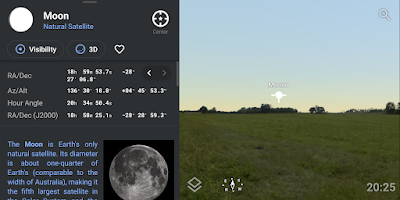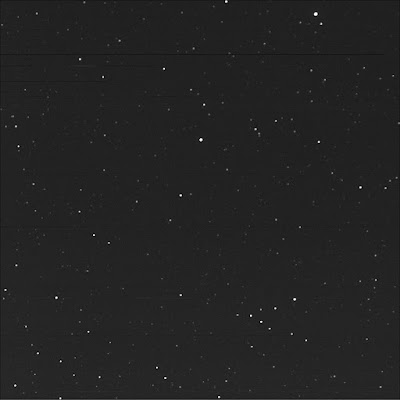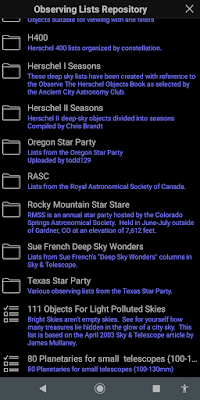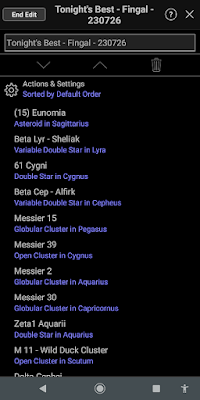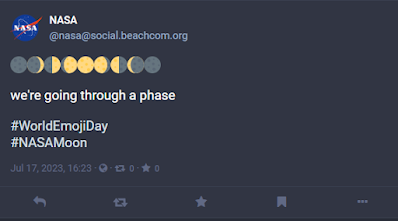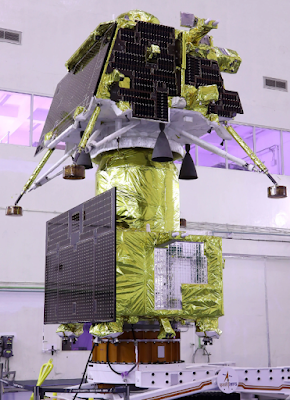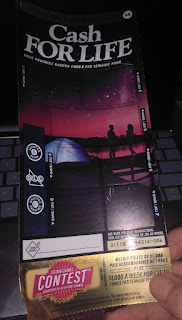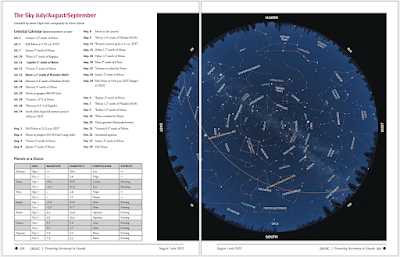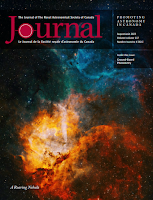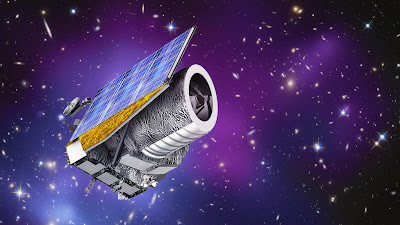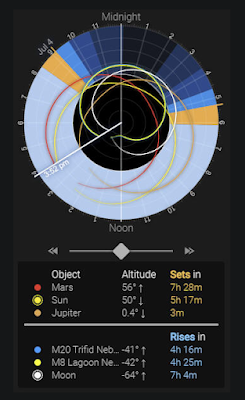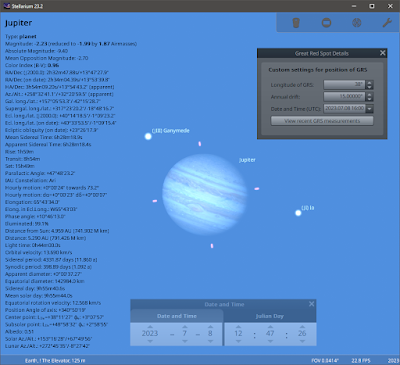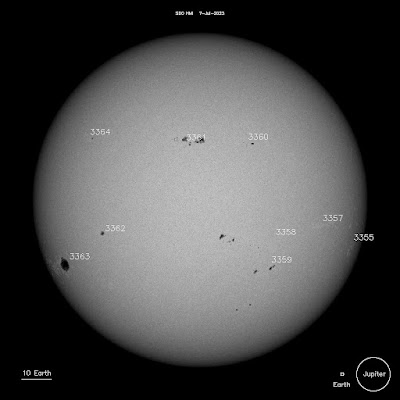Noted, front and centre, an article on Artemis 2 and it lovely spaceship.
Thursday, August 10, 2023
checked out Orion spaceship
Sunday, August 06, 2023
using an equipment list in Stellarium
Of course, Stellarium is not my prime.
But what if it was!😲😯🙀?
I was also feeling a bit of Educator Guilt: I better have the first-hand experience for any topic taught.
Fired up the Oculars window (Ctrl o). Added all my active eyepieces, added the baader Zoom, the long-term loaners. Had to look up, scour for, some data, the AFOV values. Add the three telescope OTAs. Ensured the flip settings were correct (as they are wrong from the factory). Corroborated with SkyTools.
Ignored “sensors” for now. I did not envision any special impact for the imaging crew.
Set my general options per my personal preferences (e.g. scaling).
Tested it and all seemed nominal (Alt o).
Good to practice the associated keyboard shortcuts.
It was interesting to use Venus for testing; a ultra-thin crescent. Threw me for a loop at first...
The other big part of this was retention beyond usual events, i.e. upgrades, transfer to a new computer. That in turn meant that my backup procedures first crafted in the fall of 2022 could be validated. I followed the directives for Windows in my instance. With my power-user mode hat on, renamed the oculars data content, basically a date-time stamp.
Checked the sensibly named backup file "ocular (BACKUP 230806-1701 EDT - Blake's personal).ini" which is easy to do in Windows with plain old Notepad.
Intentional modified the equipment list which forced a new backup to "ocular - Copy 230806-1916 EDT (test after edit).ini" to which an inspection showed the new datum.
But I also want to ensure users on other operating systems had access to useful information. That had been available on the lumpy darkness Stellarium evergreen web pages.
https://computer-ease.com/darkskies/sw-stell.htm
§
While Mom was here and I explained my objectives, she just shook her head and said, why is it not easy, simple. Why can't the user just click a button and everything's taken care of.
Moon muckin about
I tried to figure out the time. Confused by meds or the analogue layout or what med team wanted of me, wasn’t 100 sure. A straight arrow? That’d be 10 to 4?
§
And now I fight, post… deferred entry… with the iPad keyboard…
Thursday, August 03, 2023
learned dessert source
Cool! Dessert item from NASA. Very Cool!
How did National Aeronautics and Space Administration know I'm into human spaceflight and explor—
My sister said, "Whoa, whoa, not NASA. It's NSA."
Huh?
No Sugar Added.
Wednesday, August 02, 2023
a monster from APOD
A stunning, huge (I assume) prominence at the Sun.
With a very evocative shape.
Compare ot the visualized monster from the classic science-fiction flick Forbidden Planet.
A movie I always thought with a neat ironic aspect as the humans exploration spacecraft sure looks like the stereotypical UFO!
We come in peace...
Tuesday, August 01, 2023
orange Moon! (St Thomas)
And, again, amazing dark.
Orange-red!
Estimated 20 degrees elevation. Stellarium Mobile Plus better than me: 14°.
A magnified Mars!
Wow, a rather incredible view.
What's causing this fantastic colouring... Is it goop in the south-western sky that Luna has to climb out of? Or in the sunlight disturbed on its way to our satellite?
Forest fires?
I did not alter this photo.
Motorola e6, flash-suppressed, f/2, 1/15 sec, ISO 2344, 4mm.
changing impact factor
These things happen. If you know me, you know I have very particular perspectives on the labour side of projects when they encounter slippage. I also appreciate of the challenges presented by new projects deployed for things never done. Planning for something never tried before. Crazy.
This post might have been the one I first noticed.
Still.
A headline today (SpaceFlight Now) had a different spin or perspective...
This could introduce delays that affect... well... many other people.
Delays that would affect NASA astronauts. And other 'nauts.
Ah. Hold on.
That's a big--or a bigger--deal.
And then I thought: the Moon base? Or outpost.
I'm not sure the full impact but now I will have to dig deeper. Will Boeing's troubles spill over into the The Gateway.
They will. As I noodle on it more, it will.
They are one of the pillars...
We need the truckers. WE need the truck drivers. We need the logistics companies. WE have to haul a lot of stuff across the 400 000 kilometre gap.
Oh my.
the third is done
Wow.
This one, for some reason, took a lot of energy.
But it feels so good, so amazing, to be get past this.
And there's this whole triple connotation, the trifecta. But that goes back a decade. Might not be strictly true today, the software industry is... it changes.
Anyway, for me, that was part of a vision.
Write a column for each of the three significant software planning tools. And that ball started rolling...
SkyTools, powerful Windows-only planning tool - Apr '15
AstroPlanner, a planning tool that runs on Mac - Oct '16
Oh my Univrse. From this perspective, wow. Over 5 years.
Sorry for the delay...
Deep-Sky Planner: coming soon!
read the Monthly
Pleased to see the efforts of volunteers recogised including Chris B on the Calendar.
There was something satisfying too, in the post for the Treasurer. I don't what it is exactly... Stance, position, openness?
Note the order for solar glasses. These will be hot commodity (sorry, sorry about that) in the coming months.
Monday, July 31, 2023
taught L2C from STEGH
From the bed. Which meant no real-time mount control.
Not ideal. Lacks punch!
But it still worked. I hope. I think. I'll directly poll some of the attendees.
It's an interesting dynamic.
Ran into network TLS issues I was not expecting. That was surprising. It was good I had the remote machine pathway.
red Moon (St Thomas)
Tinted as usually seen during an eclipse.
It was ominous.
Wow.
§
In the middle of my training. Tempted to discuss it but must not very from the script!
a bit of everything
Noted the latest release of Occult, version 4.2023.7.30, by Dave Herald. Via the IOTA Daily Summary on groups.io.
Started the final edit draft version write-up assembly for the JRASC. After clearing out the previous comtent (Collimation Circles). Wanna get this done!
In my aurora portal, I noted the View Line diving pretty low. Let Sis know.
Just checked the personal inbox and spotted the RASC Weekly.
Weekly, up high, second item, featured the Stellarium level 2 happening today. Will need to rest my voice... Let the team know what's up. Lookin' forward to it...
Sky's washed out now. Feels warm out.
Noted the latest release of Occult, version 4.2023.7.30, by Dave Herald.
Chatted with, followed up with, Susan, on presentation materials derived from Stellarium.
Thinking' about the Deep-Sky Challenge. Really wanna get that done. That's a nice-to-do, the deadline is self-imposed.
Oh. And move ahead a certificate application.
finished DSC list
Perhaps something I did back in December?
Many "strangely familiar" moments.
Some loose ends. Will tidy those soon. Get Chris to have another look.
It'll be good to button this up.
Sunday, July 30, 2023
out of view (St Thomas)
The huge spot light in gone.
Well, for me.
Past the southern extent of the eastern window.
Anyone outside, heaven help you.
You can't hide.
From the Moon.
whack a Moon (St Thomas)
Pop goes the weasel.
The Moon revealed herself above the mauve bank.
Pop.
Bigger, fuller.
Mnemosyne, motorola e6, f/2, 1/30 sec, 3.54 mm, ISO 86.
§
In clear space, now to distract me.
a little tricky (St Thomas)
I saw it...
I did.
There's a bank of cloud, low.
Blue sky up high...
Through a layer, through a gap, I just saw the pale circle of the Moon.
I estimate the elevation of the Luna at 20 degrees... Seems way to much.
Less than that...
§
Stellarium reports 4° via real-time.
this can be perverted
I stumbled across an interesting quote, from The Double to the Prisoner:
"The trouble with science is that it can be perverted."
Indeed.
Our efforts are complicated and compounded.
tried to see Jupiter (St Thomas)
I think I had the best sleep in a while... maybe from 11 to 5-ish. Wow.
Looking out the big double windows, I noted a dark blue background. Some clouds, patchy, but a good chunk of sky was visible. Hmm.
I wondered if a morning planets might be visible!
What were the morning wanderers. I recalled some of the gas giants were viable.
SkySafari said Jupiter was out there. 5:45 AM. High along the ecliptic, it looked like about a 45 degree angle from the Sun.
Right where broken lumpy low clouds were parked.
I couldn't move about much, bob or weave. Or try a different hall or lawn. Just kept scanning in the south-east.
I wanted to know the exact separation between the Sol and Jove. I thought there was a way in SkySafari to do that: go to one object, go to second object, check the data, looking for "from previous." Or was that a feature of TheSky by Software Bisque? Launched Stellarium Mobile Plus. But I was thinking of Angle Measure in the computer product; no equivalent in Stellarium. Hmm. My visual gut-feel was more than 20°.
The sky brightened. The window of opportunity, for Mark-I eyeballs, was closing.
6:18 AM. The Sun cleared my local horizon. The south wall brightened rapidly. Looked like it was going to a beauty-day, eh?
6:23 AM. So, no planets. For me.
pleased to see binaries addressed
Grabbed the National Geographic magazine Special Edition Atlas of the Night Sky.
5:45 AM. Skimmed what I had read so far. Including the chapter Our Sun and Other Stars.
Page 10.
Noted, in my morning haze, the infographics in the small table entitled "Multiple Star Systems." A simple binary with equal stars to a double-double, two pairs orbiting each other.
Oh. Oh ho!
They were talking about hierarchy structures! Yes, double star types, binary systems and their masses. Very cool. I was very pleased to see this here. On many levels.
Common question raised at star parties: are these stars related?
Saturday, July 29, 2023
spotted the Moon (St Thomas)
A pale disc.
Spotted the Moon to the south-west. Low. Gibbous.
Rising and heading to the south cardinal.
Shoo. Go away.
something missing
A large family across the hall was having a little jamboree.
I'll try again later. Pay more attention.
But, I'm intrigued. The word is getting out.
And, again, I feel very aligned with Dr Smethurst...
The JWST is forcing us to go back to our data and re-examine our assumptions.
There's something wrong. Or something missing. Or something we knew about ("tired light") and decided to not include. There's something in the noise.
rolled out the DSC lists
Wow. Wow!
As big fluffy clouds rolled by, as the portable pump pumped, I made available the program target list files. I had the SkySafari list (tested, well, now), the general editable Excel file for those inclined, a PDF version of the Excel file, I recreated the SkyTools STX file.
Thought I had the Stellarium file. Reached out to Chris V.
Also made the supplement notes available, for SkySafari users.
Something I've been working on for about a year. Fits and starts.
It'll make the Observer's Handbook editor happy that I have deprecated the PDF snapshot...
Monkey off my back...
Friday, July 28, 2023
imaged rapid Barnard
Busy busy.
Centred on HIP 87937 in Ophiuchus. Barnard's Star is the bright, obvious star above and slightly-right of centre. Barnard's Star, near to Earth, shows very high proper motion, approximate 10 arcseconds per year. Everything's moving...
Luminance only, 3 second subexposures, 12 stacked shots. FITS Liberator 4, Windows 10 Paint. North is up; east is left.
We've been working at this for a few years. The archive:
§
Made a little animated GIF back on 8 May '20. Early on with just a couple of frames...
imaged the bows (St Thomas)
My sister captured many shots with her iPad Mini 4.
Surprise, surprise.
f/2.4, 1/228 second, 3.3mm, ISO 25, hand-held, behind glass.
We couldn't see it with the naked eye but the image revealed the Double Rainbow.
From my vantage, I thought it would be on the outside, further to the right. But faint.
Indeed.
one can import from the repository
And I'll only briefly mention it here... I can, if necessary, do a deeper dive later.
Into SkySafari, one can import an Observing List from the Observing Lists Repository.
This is a curated space where the Sim Curr developers have made a list to be shared with users. There are a lot of obvious generic lists (e.g. Herschel 400) and then some specialised one (e.g. Rocky Mountain Star Stare).
I was pleasantly surprised to see a category (folder) for RASC!
I plan to closely examine the RASC items. Chris and Pedro and I have already briefly chatted.
reassigned 2 Aug Stellarium instructor
He needs relief from the Stellarium assignment.
I thought about it for a bit.
I'm not busy...
It's actually a little exciting. I love teaching the level 1 intro. It's been a while.
So, pinch-hitting on Wed 2 Aug at 7:30 PM Mountain time, Blake!
received CSAC alert from BGO
There are a couple of items in the hopper but they didn't seem to be moving.
Of course, you must be patient with the Burke-Gaffney Observatory rig, as a member of the ordinary people.
Back brain, I hoped that I might see a job processed at the BGO.
Subject: CSAC Alarm for 2023-07-28 23:00:00 at BGO - SMU
Date: 2023-07-28 15:15
From: "Clear Sky Alarm Clock" <csac@casazza.net>
Favorable observing conditions at Halifax
Based on your BGO - SMU subscription.
Opportunities to observe at: (Clouds/Trans/Seeing)
07-28 @ Hour 23 for 1 hours (0%/Average/Average)
Thank you, Mark Casazza, again.
Thursday, July 27, 2023
creating an unique TB list in SS
I cannot remember clearly the process for creating a new list in SkySafari!
A special use-case container: the "what's up in tonight's sky" target list.
It's partly that I don't do it often.
It's partly that it is... a little weird. Counterintuitive. In a strange place? I really think so. Or just put it in two places.
For me, it is not a big deal, on one hand. Being in the IT biz, being a trainer, I'm used to dealing with oddities in software. I'm happy to clarify.
Perhaps some regular users out there, scratching their heads, will find this helpful.
A key feature of my procedure it makes a unique list, avoiding conflicts when using the very useful "what's new" process in the future.
The thing that keeps bugging me about all this is I've run into it before and apparently never formally documented it. Well, it's high-time.
The steps are the effectively identical for either Android or iOS users.
- Tap the SkySafari app icon.
- If preferred, allow location access.
- If nec, get to the main home screen or sub home page, so to see the celestial sphere.
- Via main toolbar... ensure the location correct.
- Via main toolbar... ensure date/time correct.
- Tap the Search button.
- Tap the Tonight's Best entry.
- Tap Actions & Settings.
- Tap Make Into Observing List, a list created called "Tonight's Best."
- Tap the OK button.
- Via main toolbar, tap the Observe button.
- Tap Observing Lists button.
- Tap the newly created list called "Tonight's Best."
- Tap the Edit button.
- Tap in the list name field.
- Annotate or extend the name, e.g. "Tonight's Best - Fingal - 230726."
- Tap the done button.
- Tap the End Edit button.
I don't know about you but I find the built-in steps not trivial. And the starting steps I find obscure! For me, I often have gone in he Observing Lists area and stared at the screen thinking "Now what?" A lot of taps.
Something that irks me about the built-in process is that they don't employ any sort of automation. Why don't they stamp the new list with the current date, time, location?! Then the user would not end up with a half-dozen or dozen lists called "Tonight's' Best." That's a dumb glitch outcome of the current process.
verifying content of SS observing list
This procedure is specifically useful for verifying the successful import of a observing list from outside SkySafari, say a target list for a RASC observing certificate program.
This yields two outcomes: the list itself and the content of the list is correct. Simple, yes, but satisfying.
For SkySafari version 6 edition Plus.
The steps are the effectively identical for either Android or iOS users.
- Tap the SkySafari app icon.
- If preferred, allow location access.
- If necessary, get to the main screen, so to see the celestial sphere.
- Tap the Observe button in the toolbar.
- From the menu, tap Observing Lists. If the list present, it signals the import steps overall worked. If the list does not appear, than the import process may need to be revisited or retried.
- Tap the imported list. Closely examine the list targets. It should show expected objects for the observing campaign.
Again, this illustrates a list with the correct items was loaded into SkySafari.
Now the user can do what they wanna do, for example, show markers on the screen by highlighting all the targets.
Or use the list as a formal checklist to show progress during an observing session.
On your bike...
importing a SkySafari observing list
So, put it on the back burner until I was able to obtain a loaner device. I felt I needed, unrestricted time, to play around for a bit. Completed my testing yesterday.
Still not quite the way I'd like I'd like to see things done but I did find a process that works for Android and iOS.
This process is specifically for SkySafari version 6 edition Plus.
§
Both of these methods I refer to as "direct copy." By that I mean that we are directly manipulating a computer file, transferring it as needed through email as a file attachment or inside a device using a file management tool.
The file is an ASCII text file so broadly supported.
The file type or extension used by SkySafari is .skylist. The ending should not be altered to ensure proper handling inside SkySafari.
§
An initial or early step in the import process of course is selecting the source file.
Yes, we're working with a proprietary .skylist data container but it is a germane ASCII computer file. A file type that can be stored anywhere and transferred by many means. At first I documented that the source file could be sent as an email attachment, copied internally, say to and from device storage, internal memory or storage drives, downloaded from web site, say from a RASC page, downloaded from LiveSky site, etc.
Broadly, I believe this still all applies though there are some heightened security restrictions with direct file wrangling.
My main objective is to use the .skylist file to help users access lists for planning purposes for the RASC visual observing certificate programs, e.g. the RASC Finest NGC Objects (broken into 4 separate files, one for the season).
Google Android
- Locate and transfer the .skylist file to import. See the notes above. One of the easiest is email attachment. Or downloading the file from a web site. Save the attached file inside the mobile device.
- Open the file management app on Android smartphone.
- Locate the .skylist file downloaded.
- Cut the .skylist file from saved location or use the Move To... command.
- Select the required target folder. The destination location is critical. Use the following path:
Internal storage /
Android /
data /
com.simultation.curriculum.skysafari6plus /
files /
Observing Lists - The selected the target folder will likely appear empty even if you have previously used it, have successfully copied other observing list files here. It is an Android file security issue blocking the display of files in the folder.
- Paste the .skylist file or complete Move To... process. The target folder will likely appear to be empty after copying but the file transferred should have worked. It is an Android file security issue blocking the display of files in the folder.
Notes: Without further testing, I cannot comment with certainty if the other editions of SkySafari would work in a similar way. For example, loading a observing list for SkySafari 6 Pro (vs Plus) might be straight-forward, only requiring the identification of the relevant list storage folder.
I thought I looked into this before, if the Basic edition of SS supports observing lists, but I've no remarks on this.
Apple iOS
- Locate and transfer the .skylist file to import. See the notes above. One of the easiest is email attachment. Or downloading the file from a web site. Save the attached file inside the mobile device.
- From the Productivity and Finance group, open the Files app.
- Locate the downloaded .skylist file. Using Search or Recent may prove a fast technique.
- Tap the .skylist file. The list will be immediately loaded into SkySafari. The SS app will be opened if it is not already running. Note a message from SkySafari that says "The observing list ... has been successfully created. " with the list name in showing. And it is followed by instructions on how to use the list.
Notes: Short and sweet.
So, there we have it.
Now, the proof is in the pudding. To gauge that the transfer worked, attempt to load the newly installed list in SkySafari.
§
Observing lists files are available for some of the RASC visual observing certificate programs. They are hosted on the RASC national web site.
- Finest NGC Objects - FNGC (broken into 4 files, one for the season)
- Deep-Sky Gems - DSG
- Deep-Sky Challenge - coming soon...
- Double Stars program - DS
A list for the Messier targets was not created by the Observing Committee as a list already exists in SkySafari.
Other lists may become available over time.
§
Note: a parameter of the RASC national web site is that the filetype .skylist is restricted. So to host the files on the RASC server, the default extension cannot be used. To quickly workaround the issue, additional text is added, an alternate extension is added, to trick the system.
After downloading the files, they will need to be renamed so that, in the end, they terminate with the .skylist extension. You need to be careful given other settings on your OS.
For example, by default, Windows does NOT show the extensions of files which complicated our efforts. Before renaming your downloaded files, change the behavior of your Windows File Explore. This is the process for Windows 10.
- In the ribbon, click the View tab.
- Click the Options button.
- Click the View tab.
- In the Advanced Settings section, in the Hidden Files and folders group, click the Show hidden files, folders, and drives option.
- Click OK.
§
QED.
let's investigate 12P/Pons-Brooks
I'll follow up later...
In daylight.
Comet 12P/Pons-Brooks is making headlines.
Curiously in a variety of ways.
But when I follow up, I will--naturally--encourage you to pay close attention to our trusted, reliable, and accurate sources.
Of these celestial objects with tails that seem to have a mind of their own...
completed testing of SS lists
Found two seemingly reliable and stable methods for getting observing lists files (the .skylist file type) in the app running on either Google Android or Apple iOS.
Rather limited paths but, hey, one good option... I'll take it.
And it was, again, disappointing, frustrating, that more things weren't possible with LiveSky. But it seems clear to me now that the scope of LiveSky is mainly backup. Which is good. Very good! Do an automatic backup of observing lists, equipment lists, locations, and so on. Life saver that LiveSky.
Coming soon: I will drop the procedural lists into a separate blog post and be sure to cross-reference too from the SS evergreen page on the blog lumpy companion.
That makes me happy.
Over the years, Chris V and I have constructed observing lists for various scenarios. My main interest is having lists to serve as planning lists for the RASC visual observing certificate programs.
These are available now, on the respective program pages at RASC.
- Finest NGC Objects (FNGC)- spring, summer, autumn, winter
- Deep-Sky Gems (DSG) - monolithic
- Double Stars - monolithic
Wednesday, July 26, 2023
forwarded some lunar suggestions
He's updating the Lunar Observing section of RASC Observer's Handbook.
He asked for suggestions. I concurred with one of his and sent along a couple of other Moon atlas titles.
"I don't think like a librarian, I guess," he said.
loaded SkySafari to iOS
This allowed me to install SkySafari Plus for iOS. iPad OS 15.7.8.
This opens the doors for any extensive testing I'd like to perform in the future.
The immediate matter was a project I had started months ago: the fully understand how to install observing lists created somewhere else, by someone someone else, into a mobile device.
The software download and install went without a hitch. Happily lots of storage space available (128 GB total) so I didn't have to worry about bumping into the furniture. Looked good on the large screen.
Heh. SkySafari sits beside Stellarium. Stellarium I had encouraged my sis to load up a few months back.
She's becoming an astro-nerd.
Nah. She's been an astro-nerd for a long time. It's that she has some of the apps now.
sent T-1W reminder
Al M is on deck for this session.
Wed 2 Aug ‘23 - 7:30 PM Mountain Time.
Helping us keeping on track.
Wow. August.
...
Documented the procedure. Succession planning.
started into Nat Geo
Number One Sister purchased a copy from one of the other Shoppers Drug Mart stores in town.
I first heard about this Nat Geo publication on the RASC forums.
Will report more...
35 maps inside!
Monday, July 24, 2023
delivered the first jam session
Went well.
Good turnout.
Time flew!
For me anyway.
Good news for us; bad news for the Richmond Hill DDO: Chris V was able to pop in due to poor sky conditions.
It played out as I had expected or hoped with a mix of questions, discoveries, opportunities to trouble-shoot problems, time-saving techniques, and so on.
And, along the way, we started to build a wiki, documenting our discussion. I'll give the attendees co-authoring access and we'll share to all others.
§
"Delivered" is not a good word. Presided over... I tried to not teach, command, lead. It was my goal to give everyone equal time and space on the floor. So I didn't deliver; I faciliated.
checked out the Weekly
No mention of the upcoming Stellarium sessions. To be fair, the one this week, the Jam Session, was being treated differently... Flying it under the radar.
Now, other items caught my eye...
There's a talk called Age of the Universe offered by the Dunlap Institute for Astronomy and Astrophysics on Wednesday, July 26, 2023 - 9:00 AM to 5:00 PM EDT. It is a workshop for grade 11 and 12 students in the GTA. Lots more information on the DI web site. Hot topic now...
And finally, Toronto Centre's Quinton Weyrich will discuss Taking Back the Night Sky: What We Can Do About Light Pollution. A very important topic for all. Located at the David Dunlap Observatory on Saturday, July 29, 2023 - 9:30 PM to 11:30 EDT, there will be telescope viewing. Hopefully through clear skies. See the registration page for more info and fees.
Friday, July 21, 2023
processed apps
Added invitees to the new Jam Session.
Registered people to the level 2 intermediate.
And processed humans for the level 1 introductory.
Thursday, July 20, 2023
new to astronomy, is it all Greek?
For the actual astronomers for the Actual Astronomy team, Shane and Chris, I recorded a session where I shared some tips, tricks, information, what I consider essential information actually, that the new astronomer needs.
It is mind-bogglingly important to me.
I feel fortunate that I stumbled across this at such at early stage and tried to master it. It has proven very useful.
The topic: The astronomer needs to know the Greek alphabet.
Related topic: The astronomer needs to know the Greek alphabet and how it is used in the hobby.
Helps find things. Helps demystify charts and atlases. Clarified double stars catalogues.
So give a listen to podcast 343 entitled It's All Greek To Me. (Hosted at PodBean.)
And give a gander of the associated show notes.
to be in the Library
I'm trying to understand how lists make it to the Community group.
And if she vetted the data.
Gave a quick answer and said she'd check her notes.
§
My requests to join the related DSP were accepted. Curiously, they are empty...
Wednesday, July 19, 2023
received official notice of the Journal
Subject: The August 2023 Journal is Now Live!
The current edition was now available to members, PDF of course.
Still curious to me that it is available for a while but the notice is rather delayed... odd sequence.
Tuesday, July 18, 2023
she's not convinced
Ah ha! On the research paper on the proposed new age of the Universe! 26.7 billion years.
Double.
I saw this paper announced back on 12 Jul '23 at EurakaAlert. Noted it was by a Canuck. I wondered what sort of shock waves this might send through the community.
It's a radical stance. And some things she found intriguing. But closed saying, "I'm not convinced."
Becky Smethurst, astrophysicist at Oxford, promised a more thorough review soon. I look forward to that.
learned of current crew
I was pleased to see this. In the spirit of communication, transparency, etc.
Entitled "MEET THE RASC EXECUTIVE AND BOARD."
- Michael Watson, President
- Brendon Roy, 1st Vice-President
- Betty Robinson, 2nd Vice-President
- Eric Briggs, Secretary
- Katherine Dulong, Director
- Vikki Zsohar, Director
- Randy Attwood, Director
- Stuart Heggie, Director
- Andrew Bennett, Director
Some fresh meat.
Monday, July 17, 2023
happy emoji to you
Spotted this on my Mastodon feed.
Ha.
I only like one (or two) of those.
learned of landing attempt date
Informative and entertaining as always.
And he noted August 23. This appears to date of landing attempt.
Near the south pole. That's the target, as before.
This is a follow-on from my piece a couple of days ago.
found neat ELT video
A cool short little video on the ELT.
Some time lapse, some of the humans, an upbeat sound track.
Enjoy.
§
Oh, and includes image of the Extremely Large Snowman...
Sunday, July 16, 2023
another set of eyes
He had listings for where planets were and interesting events for the year.
I had some time...
Using Stellarium 23.2, I checked all and made comments.
For independent cross-checking, and to try to ensure we hadn't missed any big events, I ran a hybrid report from SkyTools 4 Visual Pro.
Hope it helps.
received ABN newsletter
Main subject: Lessons learned from an unusual nebula.
Looks like I've a bit of reading to do.
review posted
He also linked to the RASC web site.
He has my gratitude.
§
Simon added a more detailed note to his blog. And a full display of the PDF extract!
He also tweeted about RASC.
Universe blocker
Lots of good discussion.
"Why are we here? Who are we? What is the meaning of life? We revisit an episode where Neil deGrasse Tyson and comic co-host Chuck Nice answer fan-submitted Cosmic Queries on topics that stem from the deepest thoughts, ideas, and feelings we share about our place in the universe."
Then they get to the lightning round near the end. The question asked was, effectively, what would things be like if we didn't have a Moon.
"The moon wreaks havoc on our ability to see the rest of Universe."
He said it, not me!
You can see 3,000 to 4,000 stars with the unaided eye, but if the Moon's out you can only see 300.
"The Moon is basically a pain in the..."
I'll let you enjoy the rest...
Stoopid Moon.
returning to Luna
The Indian Space Research Organization (ISRO) launched yesterday.
I still cannot find specific dates for the Chandrayaan-3 mission. Not sure when they are due to arrive the Moon or touch down...
We'll stay tuned!
§
Scott Manley provided an update.
Saturday, July 15, 2023
coming together
A full treatment here might take ma a couple of hours to write out. Too much. I can't do it. Not now. And I'm not sure the true value. But here is the highlight, the main take away.
Importing bookmarks lists into Stellarium 23.2 is functional.
I say again, it is functional.
It works. It is not perfect, there is a bug, a minor one. While annoying, it is easily addressed.
When you import a list, you simply need to shutdown and restart Stellarium to see and use the list.
Today's important discovery is that the incoming list will be correctly labeled, and perhaps show with its good description, with no action required. The list may be immediately useable. This I did not think possible. But it turns it, it has to do with the JSON file schema.
Simply put, if the correct schema is used, the list appears correctly.
It's still not the end of the world if an inappropriate schema is used; it just means the list needs needs to be modified, given a good name and an optional description.
My editing notes should be taken with a grain of salt.
You know that feeling. You're on the road, heading to your weekend destination, and you think, "Did I turn the stove off?"
The nagging thought, the question you can't answer, the image you can't crystalise.
Something had been bugging me for days about all this... I think I found it today. All kinds of loose ends got sorted here just now. Synchronicity. Richard's observations of the file structures that did not fully registering with me. Chris's reporting of lists importing without issue not fully registering with me. Me not seeing it happen first hand.
This also revealed a predictive tool. Examining the file schema tells us what will happen during import.
SWPC retracted an alert
The Space Weather Prediction Center clawed back a notification.
Subject: CANCELLED WARNING: Geomagnetic K-index of 4 expected
Date: 2023-07-15 14:43
From: SWPC Product Subscription Service <SWPC.Products@noaa.gov>Space Weather Message Code: WARK04
Serial Number: 4414
Issue Time: 2023 Jul 15 1840 UTCCANCEL WARNING: Geomagnetic K-index of 4 expected
Cancel Serial Number: 4413
Original Issue Time: 2023 Jul 14 1552 UTCComment: Canceling because conditions are currently quiet and the end date needs to be corrected anyways.
Potential Impacts: Area of impact primarily poleward of 65 degrees Geomagnetic Latitude.
Induced Currents - Weak power grid fluctuations can occur.
Aurora - Aurora may be visible at high latitudes such as Canada and Alaska.
How about that.
I actually really appreciate this.
An official source keeping us up-to-date in all aspects, even when the prospects are not positiive.
Just what need in the fight against misinformation.
helped with backdrop
I encouraged her to review her notes from the level 3 advanced training. Wondered if she had a chance to re-examine the steps documented in the Quick Reference Card.
She had tried some panoramic photos with her smartphone but was not happy with the results. I said I tripod wasn't necessary but grey clouds, an evenly overcast sky was best. She said she'd try again, once the smoke from the fires was gone.
All she'd need then was an image editor. She uses Dark Table. I think that'll be fine.
Reviewed my notes when I tested a single pano from the motorola. Arguably the easiest, fastest way to get a custom background into the planetarium.
Friday, July 14, 2023
received little gifts
Then she presented a couple of little gifts. Aww! Thanks!
First was a pen, fine tipped. On board, a little astronaut!
Cute.
Second, presented a lotto ticket. Mostly for the background image.
Stars over the lake. People camping. Astro-tourism is a thing!
found comets in Windows
I had noticed it before, in passing.
Checked for it, today, explicitly.
Having reloaded Stellarium (full complete uninstall and reinstall) onto John Grim, it gave me a chance to examine it closely.
The Windows deployment of Stellarium 23.2 includes many current comets.
In general, I believe this applies for comets in 2022 and 2023. To be precise, comets with the formal designation beginning C/2022 and C/2023. For example, you'll find C/2023 E1 (ATLAS), C/2023 A3 (Tsuchinshan-ATLAS), and C/2022 A2 (PANSTARRS) already in the application.
Other comets outside these epochs, new discoveries of course, you'll need to load (using the Solar System Editor plug-in).
OK.
The reason I raise this is because it was not done in Linux. I would have never known this if it wasn't for using Ubuntu on daily basis...
I wonder now what's up for the Mac crew. I'll test on Mom's when I have a chance. Maybe Ian B will have a peek.
Regardless, it is odd, me thinks, that it is not done for all. Does this mean the Linux people don't talk to the Windows people? Silos over in the Stellarium camp?
together again
The table was shown on the right when it should have been the left-hand page.
I was viewing the PDF in a browser.
Presumably, for RASC members buying the hard edition, all is well.
On John Grim, the Surface Laptop Go machine, I have made a concerted effort to not load it up with too much software and definitely to avoid duplication. Don't need half-dozen browsers and four image editors and a couple of PDF readers. The SSD within is not capacious. Given the modern browser can display PDF files (in a basic fashion anyway), I chose not to install a formal reader app.
This meant I was to view the RASC publication in Chrome. And that in turn meant I had limited control over the rendering of the file in its portable format. Same deal on John Valuk, I use the PDF rendering within Firefox (although the PDF reader onboard). The way the cookie crumbles (no pun intended).
On a lark, I wondered what I could do over on John Starbird. Lots storage space on the new ASUS (light-weight) gamer tower. Still careful what I install but on that box, I had loaded in FoxIt. A lovely, feature-rich, free, powerful reader of Portable Document Format files.
But, immediately upon opening the Journal, I saw I was faced with the same issue.
OK, Google, any ideas? Well, Google didn't know but it directed me into to the Knowledge Base (there's a phrase I haven't heard for a long time) of the FoxIt software no less. The tip said to activate the Separate Cover Page option. Whatever that means. Bingo!
Doesn't that look nice.
What does this mean, in the end?
Nothing really. Just my OCD, my visual eye, me wanting balance. That I receive the digital edition of the Journal, this is just... stuff that happens.
verified mount control in Stellarium
More ways that one.
The big thing is that I wanted to see the Super Polaris move under the control of Stellarium 23.2.
Short report: it worked.
I was not anticipating any issues. But there are, of course, a lot of links in the chain.
When it works, curiously, it's fiddly, bothersome, tedious, mundane. You just gotta do all the things, all the steps, sometimes in the particular order. Denouement.
So, for the books:
- Microsoft Surface Laptop Go
- 64-bit Windows 10 Home
- 32-bit Stellarium 23.2
- ASCOM platform 6
- 32-bit Vixen SkySensor 2000 ASCOM mount driver
- Staples USB-serial adapter - Prolific chipset
- custom data cable
- IDEA GoToStar motor control system
- Vixen Super Polaris German equatorial mount
I was happy to tick a box or two.
§
All this is good news too for field use. I still don't think I've used it, John Grim, in the field yet to drive the mount. My runs to date, I've used a combination of the GoToStar hand controller, star hopping, and field hopping. I definitely not used SkyTools. Just haven't wanted it enough.
An end goal is SkyTools use so there are some checkpoints to pass there but this paves the way. The ASCOM parts are in place. Just need to hook SkyTools up to the ASCOM bits. Should be easy. Right?
for dark and quiet skies
It is fascinating!
He speaks with Dr Moriba Jah.
The current state of issues in low Earth orbit, geosynch, space junk, old gear, etc. Tracking, transparency, accountability. What lessons can we learn, what can the actual physical space sustain... It is incumbent for all of us, of course.
Much to absorb.
§
He mentioned it, his web site, and I found it up and running!
extremely large snowman
Middle of the night, trying to followed my directions, getting the next reminders in the calendar, squinting at Mnemosyne, brightness set very low, double-checking, triple-checking, then one last verbal command...
And, as usual, now I'm alert. Disturbed. Awake. Brain activated. I think.
Well, what's going on. At 4 AM?
Not much.
No emails.
No notifications.
No new photos from sis.
I launch Chrome.
On the mobile device, Discover launches. The Google Machine dangles my carrots: Formula 1 spoiled brats, camera vintage lenses, space agency updates, fires across Canada, all important cat videos.
Then an image jars me, I stop swipping.
What the Universe?!
Shake my head.
What?
Look again.
Could it be?
A snowman?
It looks like a snowman! Snowman's head. Big round head, top hat, charcoal eyes, a long orange carrot for a nose.
I squint and shift and bob and move the phone back and forth for the sweet spot.
It's a snowman!
Funny. A very funny, odd effect with this image shown, the low light level, the teenie display.
Do you see it? What do you think? Sit back, squint, turn your monitor brightness down. Do you see it? See the face? See the snowman?
OK. Maybe not...
Maybe I'm a little funny in the head.
Anyhoo. The copy then pulled me away.
The article is about the Extremely Large Telescope in the Chillean Atacama Desert. Ooh. Interesting.
It is a progress report. The Extremely Large Telescope is halfway complete.
And then, as I try to read the article proper, I start nodding. Re-readding the first paragraph a fourth and fifth time.
OK. Yes. I really am tired.
So I push it into Evernote.
And lights-out.
§
Jacinta Bowler gives an update, from 12 July 2023, on work with the ELT. The Extremely Large Telescope is part of the European Southern Observatory (ESO) complex. When complete, it will be the largest visible and infrared light telescope in the world. Using hexagon mirror segments, like the JWST, it will be more than 39 metres in diameter.
It's a short piece but with a couple of cool photos.
I was intrigued as to progress of the build, being very interested in gneeral in project management and megaprojects. Happily, Bowler reported that the team was on target and they expected to see "first light" by 2028.
review received well
Often I receive an acknowledgement, which is fine. But every once in a while, a genuine heart-felt reply, an expression of gratitude.
I was very happy to hear from Simon of Collimation Circles.
Thank you very much for sending me your article. It's really very well written and so interesting to read. I'm so glad that experienced astronomer like you find it useful. It is really great to be acknowledged by someone of your status, experience and deep understanding of telescope inner working.
Neat that part, an experienced user commenting on software. That adds some gravitas to the product, which might prove helpful to savvy users looking at the convenience factor. While extremely useful to the novice. Simon has satisfied all user levels.
Happy campers, both sides.
started the Backyard page
Over on the evergreen area, I rolled out the new Backyard software page.
The software training course is the impetus here.
I need a hub for items related to the Backyard EOS and Nikon software. To help users get up and running in the software, share tips and tricks, quickly answer questions.
Made the stub. It'll take a bit to flesh it out.
Thursday, July 13, 2023
HBD JWST
One year old!
downloaded the August Journal
Found it. Found the August issue.
Incredible evocative image on the cover, the Lion Nebula by Steve Leonard, using the Hubble palette.
Honoured to share pages with John Percy again: he talks about why we should care about the cosmos.
I look forward to diving into the What's Up In The Sky, with event list and whole-sky chart, again.
My regular column, Binary Universe, starts on page 163. I discuss the new brilliant Collimation Circles tool.During the proofreading phase ahead of publication, I asked for a small note to be added to my piece, to accommodate for very rapid changes to the app, some that affected the interface. I wanted to warn the new user that my notes and screen shots were already off a bit.
This request was rejected: the editor argued there was no space. That was unfortunate.
I include my cautionary note here:
In the short time since submitting my draft and receiving my proof, Collimation Circles has undergone major changes. That's what you get with beta software released into the wild! The GUI (interface) was revamped but I don't think you'll have too much trouble navigating the new screens. Another big change? CC can now help with focusing by showing the Bahitov diffraction pattern. Just gets better!
Also, an errata shows on page 135. This corrects for bad and confusing copy in my article in the June issue (page 125). This is the public notice, in addition to the direct apology sent. Again, the electronic version of JRASC was corrected; this affects those who receive the print edition.
§
Once again, there are faulty links, link "zones" in the file. Fortunately, the hyperlink from the TOC is OK and within the BU article to the software site; page 154 however... the whole page flips later in the issue, that's confusing and disorienting. It also masks the IOTA link. Increasingly, I don't feel the editing team appreciates this, truly groks hypermedia.
§
The software author noted JRASC on their web site. Thanks for the loop back!
Wednesday, July 12, 2023
a new authority on aurora?
Some of the keywords or phrases I use include "dark matter" and "light pollution."
A couple of days ago I spotted this.
On My Universe.
Really?
Yahoo!Sports is now an authority on celestial phenomena?!
Many years ago I left Yahoo in frustration. Back then, I shouted, fist shaking at the screen, "Focus!"
Yahoo had lost their focus.
I also checked for the person responsible:
Maggie Horton.
I learned that she covers entertainment, celebrity news, TV shows and movies. Purportedly she enjoys concerts and nature.
Uh huh.
We can look forward to poorly-timed misinformation getting people riled up for no good reason. More fake science news.
Dear reader? Check your sources.
Tuesday, July 11, 2023
sought updates
Euclid is the latest space telescope to depart Earth. It was successfully launched with a SpaceX booster from Cape Canaveral on Saturday 1 July. Heading for a Lagrange point, the telescope designed by the European Space Agency will study dark energy.
I found an article as NASA on the launch and mission.
Yesterday, found a page from Adda247 that looked current but upon examination I saw images of a Soyuz craft in low Earth orbit. Headline read, "ESA launches ‘Euclid Space Telescope’ to review solar system bodies." Sheesh. Moving on.
Today I found the consortium page. Ironically, they discussed being current and "going public" on a page edited in late March. Meh.
Tried a quick search of the ESA web site. Search result page blank. Their overview page is good though.
Cool stuff at the amazing wikipedia, of course, including animated orbit diagrams.
At last, I found a source for current info. They're using mastodon.
https://astrodon.social/@ec_euclid
I linked to it.
Getting busy over in the L2...
x
See Dr Becky's YouTube video. She discusses how ESA plans to tackle dark matter and dark energy mysteries.
Monday, July 10, 2023
offered the first jam session
This is for the participants who have gone through all the training courses we have to offer but still want more.
Stellarium is big.
But rather than use a strict agenda and an constantly-talking instructor, we're going to use an open format,
We will encourage the participants to bring their issues, questions, and troubles and we'll work on 'em together.
I made an info web page, picked a date, and started sending out invitations.
Exciting!
forwarded a cert
16 for the year.
Sunday, July 09, 2023
learned of astronomical clock
Now, Astrospheric is already a pretty awesome wx resource. I really like the sinusoidal charts for the Sun and Moon and the temperature line plots for ambient and predicted dew point.
A relatively recent addition was the kp-index row.
Wish it had barometric pressure, but hey...
The CN notification highlighted a new feature, a new graph, available to all users.
I hopped into my weather portal for St T and clicked the link, tuned for my lat and long. I found the new element at the bottom of the main screen.
I'm a sucker for cool infographics that actually work! Immediately, I liked it! At a glance, a ton of information. And interactive too!
It's called the Astronomical Clock.
VERY interesting.
Time dial can be manually set (it is extremely sensitive).
Targets can be added based upon user preference. One can choose from the Messier, NGC, IC, and Abell catalogues. What about comets?! That'd be cool. Didn't seem to work. Well, there was no listing of current comets... But objects could be included with RA and Dec. That'll do.
Then, items in the clever circular chart, could added up top in the sinusoidal. Wow. Impressive. A very handy and easy way to assess visibility night by night, especially when battling the stoopid Moon.
Astrospheric just went up a notch, a big notch!
Note: Tested on 64-bit Windows 10 Home in Chrome 114. Haven't used the mobile app for eons.
Saturday, July 08, 2023
disturbance
It may be right.
had a laugh
From Mia, a participant in a recent level 3 advanced Stellarium session (I taught L3C on 28 June).
She shared:
Good Afternoon Blake, I want to extend my gratitude for last week's Stellarium Level 3 course. I very much enjoyed it and I look forward to applying what I learned out in the field. I was also very entertained during the course, and will now always refer to the galaxy icon as "the flying star of death."
Ha.
My nickname for the nebula or deep-sky objects button in the horizontal toolbar.
Funny.
salvaged a solution
I was able to import an observing list into Stellarium!
I made it work. Holy Universe, we have a pathway—for the time being. It's clunky, it requires some fiddling, some carefully documented procedures. But we can make it happen.
For the time being, I am so happy to offer a solution.
§
This goes back to something a couple of days ago, early in the testing. I attempted to import a list, as noted, and nothing seemed to happen, at the moment.
Later in testing, almost out of the corner of my eye, I saw something new. At the time I missed it sequentially, when it happened. But now I know the particulars.
If you import a list, the software does not show anything immediately. It truly appears that nothing happened. But in fact the data was imported.
To see the result of the import, you must shutdown Stellarium and relaunch it. Then you'll discover an entry marked "bookmark lists" with description text "Bookmarks of previous Stellarium version."
First time I saw it, it looked random to me, a bunch of stars by the HIP number, and I just ignored it, moved on with other tasks.
§
Moving forward. I read the GitHub note that Chris V had shared and noted one of the devs saying something along the lines of an odd behaviour occurring and a new list with content appearing.
Ah. Same as me.
But, again, it went on the backburner.
§
Today, at the beginning of trying the personal-use-only test, I noted three generic entries in the observing list menu. Where did they all come from? Spawning?
I thought back. Well, last night I had, on a whim, tried importing, specifically from a target list not copied to John Grim before, the spring segment of the RASC Finest NGCs, downloaded from the Toronto Centre archive.
And then something clicked. No, not my bones.
I switched to these lists.
One, nothing, empty.
The second one: HIP stars. Those are from the RASC Double Stars program! I'm sure. I had imported them successfully but not reaslised it!
Third one, UFO Galaxy, Lost Galaxy, the Eyes including NGC 4438. A quick glance at the official RASC program target list... yeppers. Entries from spring FNGC! Inside Stellarium. In a distinct list!
And there it was.
While poorly labeled, these entries were absorbed into an observing list through the import process.
Up to this point, I thought the import was completely broken, so then making it impossible for us to transfer lists between computers. But joyfully I was wrong.
§
Here is the procedure for Stellarium version 23.2 with integrated work around, adapted from the instructions in the Quick Reference Card.
Import an Observing List
- Access a source for Stellarium observing list. E.g. Toronto Centre archive.
https://rascto.ca/astronomy/stellarium-observing-lists - Download a prefab observing list/bookmarks JSON file.
E.g. RASC Finest NGC Spring targets list. - Click the Observing lists button or press Alt b or ⌥ B. The Observing lists window appears.
- Click the Import list... button.
- In the file dialogue box, locate the preferred JSON file, and click the Open button.
E.g. RASC Finest NGC Spring v2.json - Shutdown or quit Stellarium.
- Relaunch Stellarium.
- Click the Observing lists button or press Alt b or ⌥ B.
- From the List menu, choose the entry marked "bookmark lists." There may be more than one. Ensure the correct entries appear in the list area.
E.g. includes UFO galaxy aka NGC 2683. - Click the Edit list button.
- In the List name field, enter an approrpriate brief title.
E.g. RASC Finest NGC spring - Optionally, enter a description.
E.g. RASC observing certified list. Bookmarks of previous Stellarium version. - Click the Save list button.
And you're done.
Double the steps but hey...
§
Chris corroborated my findings.
§
Re-examined the importing process and made some important discoveries. Read this important update for the full picture...
It also impacts the procedural instructions above...
checked the GRS
I wondered what might be up with the Great Red Spot position in Stellarium. Wondered if all was well in the latest version 23.2.
Nope.
Wrong-o!
Found the GRS is off. Couple of hours...
Compared first with the Sky & Telescope magazine online tool. Then with SkyTools 4.
Using the integrated view option in Stellarium, linked to JUPOS, I estimated the position to be at 38°. Handy. Back in the form, I entered the 38 degrees value.
Then I set the epoch time to the current date, right to the hour, in other words: now.
The GRS snapped into place, close to the meridian, for my reference time. Looked OK.
All this revealed that the Stellarium dev team is not updating the Jupiter data when rolling out releases. Too bad.
I think a lot of us having just been assuming that...
Reasonable!
Ooops.
Let my training team know.
§
Let Chris know. He was disappointed too.
time to test
So, started working...
Did a mock teach of the Stellarium level 2 intermediate course with release 23.2.
Overall, no impact. Very good news.
Ha. At one point I set the time to "now" in the planetarium. Wondered why the virtual sky was bright.
Duh.
Friday, July 07, 2023
saw Newton's model
He was at the Royal Society examining one of their most prized artefacts, a model of the reflecting telescope designed and made by Sir Isaac Newton.
There were detailed drawings too.
Wood, paper, brass, and a tiny silver mirror.
Neat to see a real one with the sliding inner optical tube and the ball-joint mount.
debunked TWN again
They were pleased to hear from me and keen to learn my response. They wanted my expert opinion as it were.
The Weather Network was on about aurora.
Oh brother, not again.
I shared that while I had received an email alert, it was not at a high level. I reminded them of the 1 to 10 scale. My notification was at 4.
I wondered if the large sunspot was getting them riled up. That region might produce aurora but I didn't think it would come into play for a day or two.
Don't forgot the bright Moon. TWN always forgets to remind their audience of that. Goofs.
Still, I loaded up my wx portal and hit the NOAA aurora link.
Gah. 404. They moved things around again.
Clicked about and found the new SWPC dashboard page.
As I suspected: all green.
Anyone wanna drive to northern Saskatchewan?
discussed target lists
Huh.
Set up a Zoom meeting to discuss the various factors.
He's a variable star guy.
Introduced the Astronomical Calculations window. It might offer some immediate solutions; it did. But it was a closed system requiring effort from the development side. Exporting possible but without a JSON option.
Introduced the Observing Lists / Bookmarks window. It illustrated how Chris V and others had made shareable lists. But pointed out importing wouldn't work and how this stonewalled our work. Indecipherable JSON files.
Told Rick that the dev team is aware of the issue.
We left it, such that it was, to keep in touch. We need to see what happens in version 23.3 or .4 and if we can progress in any meaningful way.
Closed off on presentation tips ideas.
Good quick meet.
§
Informed Rick of my discovery, that the import process does work, with a gotcha.
on gravitational waves
This is exciting stuff!
Very exciting...
She talks about the incredible multi-year achievements into the isotropic background signal. Not to be confused with the relatively recent LIGO results showing our first gravity wave detection.
I wrote in awe about this in early 2016. I also compared things at the microscopic and macroscopic levels in July 2016. And in August 2017, I briefly noted the neutron star merger results.
She also referred to Katie Mack who talked about how this is like being on a boat and feeling the choppiness on the ocean. Great analogue.
[ed: Mack is a speaker at Starfest...]
Becky then said, "Before gravitational waves, we only had light"
There it is. I felt exactly this with the LIGO results.
I knew it! This was the opening of a door. We were "seeing" the Universe in a way we'd never done before. I harkened it to a people deaf from birth, perhaps through a new medical procedure, hearing sound for the first time.
There is a sea of data out there waiting to be discovered... It is a "new realm."
Gravitational waves, large, and now small, are showing us the Universe beyond the constraints of light. As significant as it is, the cosmic microwave background (CMB, CMBR) limits us to light! And that curtain has been closing in...
Messengers.
I joked about gravity-wave phones...
Gravity studies are changing this.
Completely changing things.
Piercing the veil.
Circle your calendar.
§
I've been flashing back to the 70s/80s when I was deep in imaginings and keen to write science fiction stories and, inspired by Larry Niven, started to create an entire future history. I digress. But one technology I "invented" for my stories was using pulsars around the galaxy to serve as clocks, to keep everything on time, to run the trains on schedule as it were... Ha! Weird.
comin' 'round the bend
Well. More correctly, keep an eye (protected, of course) out for one of the largest sunspots in a while.
Twisting into view is a large feature.
I saw them talking about it on SpaceWeather, that it is was easily spotted from Mars.
Find your solar eclipse glasses.
It might be easily photographed at sunrise or sunset (but PLEASE be careful).
Ensure you eyes and/or camera are properly filtered.
It's huge.
Thursday, July 06, 2023
clarified some DSGs
Indeed, Levy 401 and 403 will require some averted... vision.




